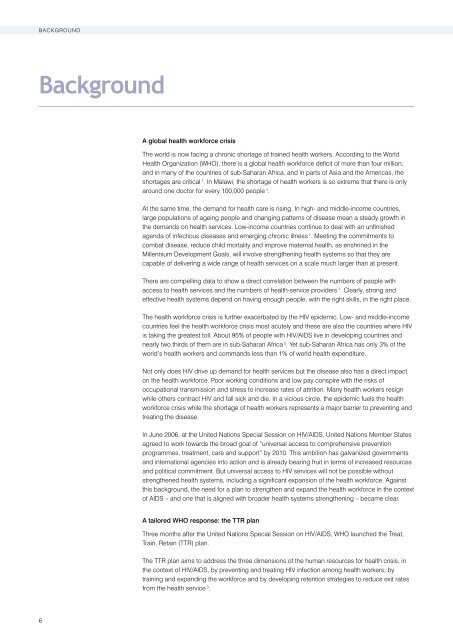Task Shifting - Global Recommendations and Guidelines - unaids
Task Shifting - Global Recommendations and Guidelines - unaids
Task Shifting - Global Recommendations and Guidelines - unaids
Create successful ePaper yourself
Turn your PDF publications into a flip-book with our unique Google optimized e-Paper software.
ackground<br />
Background<br />
A global health workforce crisis<br />
The world is now facing a chronic shortage of trained health workers. According to the World<br />
Health Organization (WHO), there is a global health workforce deficit of more than four million,<br />
<strong>and</strong> in many of the countries of sub-Saharan Africa, <strong>and</strong> in parts of Asia <strong>and</strong> the Americas, the<br />
shortages are critical 1 . In Malawi, the shortage of health workers is so extreme that there is only<br />
around one doctor for every 100,000 people 1 .<br />
At the same time, the dem<strong>and</strong> for health care is rising. In high- <strong>and</strong> middle-income countries,<br />
large populations of ageing people <strong>and</strong> changing patterns of disease mean a steady growth in<br />
the dem<strong>and</strong>s on health services. Low-income countries continue to deal with an unfinished<br />
agenda of infectious diseases <strong>and</strong> emerging chronic illness 1 . Meeting the commitments to<br />
combat disease, reduce child mortality <strong>and</strong> improve maternal health, as enshrined in the<br />
Millennium Development Goals, will involve strengthening health systems so that they are<br />
capable of delivering a wide range of health services on a scale much larger than at present.<br />
There are compelling data to show a direct correlation between the numbers of people with<br />
access to health services <strong>and</strong> the numbers of health-service providers 1 . Clearly, strong <strong>and</strong><br />
effective health systems depend on having enough people, with the right skills, in the right place.<br />
The health workforce crisis is further exacerbated by the HIV epidemic. Low- <strong>and</strong> middle-income<br />
countries feel the health workforce crisis most acutely <strong>and</strong> these are also the countries where HIV<br />
is taking the greatest toll. About 95% of people with HIV/AIDS live in developing countries <strong>and</strong><br />
nearly two thirds of them are in sub-Saharan Africa 2 . Yet sub-Saharan Africa has only 3% of the<br />
world’s health workers <strong>and</strong> comm<strong>and</strong>s less than 1% of world health expenditure.<br />
Not only does HIV drive up dem<strong>and</strong> for health services but the disease also has a direct impact<br />
on the health workforce. Poor working conditions <strong>and</strong> low pay conspire with the risks of<br />
occupational transmission <strong>and</strong> stress to increase rates of attrition. Many health workers resign<br />
while others contract HIV <strong>and</strong> fall sick <strong>and</strong> die. In a vicious circle, the epidemic fuels the health<br />
workforce crisis while the shortage of health workers represents a major barrier to preventing <strong>and</strong><br />
treating the disease.<br />
In June 2006, at the United Nations Special Session on HIV/AIDS, United Nations Member States<br />
agreed to work towards the broad goal of “universal access to comprehensive prevention<br />
programmes, treatment, care <strong>and</strong> support” by 2010. This ambition has galvanized governments<br />
<strong>and</strong> international agencies into action <strong>and</strong> is already bearing fruit in terms of increased resources<br />
<strong>and</strong> political commitment. But universal access to HIV services will not be possible without<br />
strengthened health systems, including a significant expansion of the health workforce. Against<br />
this background, the need for a plan to strengthen <strong>and</strong> exp<strong>and</strong> the health workforce in the context<br />
of AIDS – <strong>and</strong> one that is aligned with broader health systems strengthening – became clear.<br />
A tailored WHO response: the TTR plan<br />
Three months after the United Nations Special Session on HIV/AIDS, WHO launched the Treat,<br />
Train, Retain (TTR) plan.<br />
The TTR plan aims to address the three dimensions of the human resources for health crisis, in<br />
the context of HIV/AIDS, by preventing <strong>and</strong> treating HIV infection among health workers, by<br />
training <strong>and</strong> exp<strong>and</strong>ing the workforce <strong>and</strong> by developing retention strategies to reduce exit rates<br />
from the health service 3 .

















